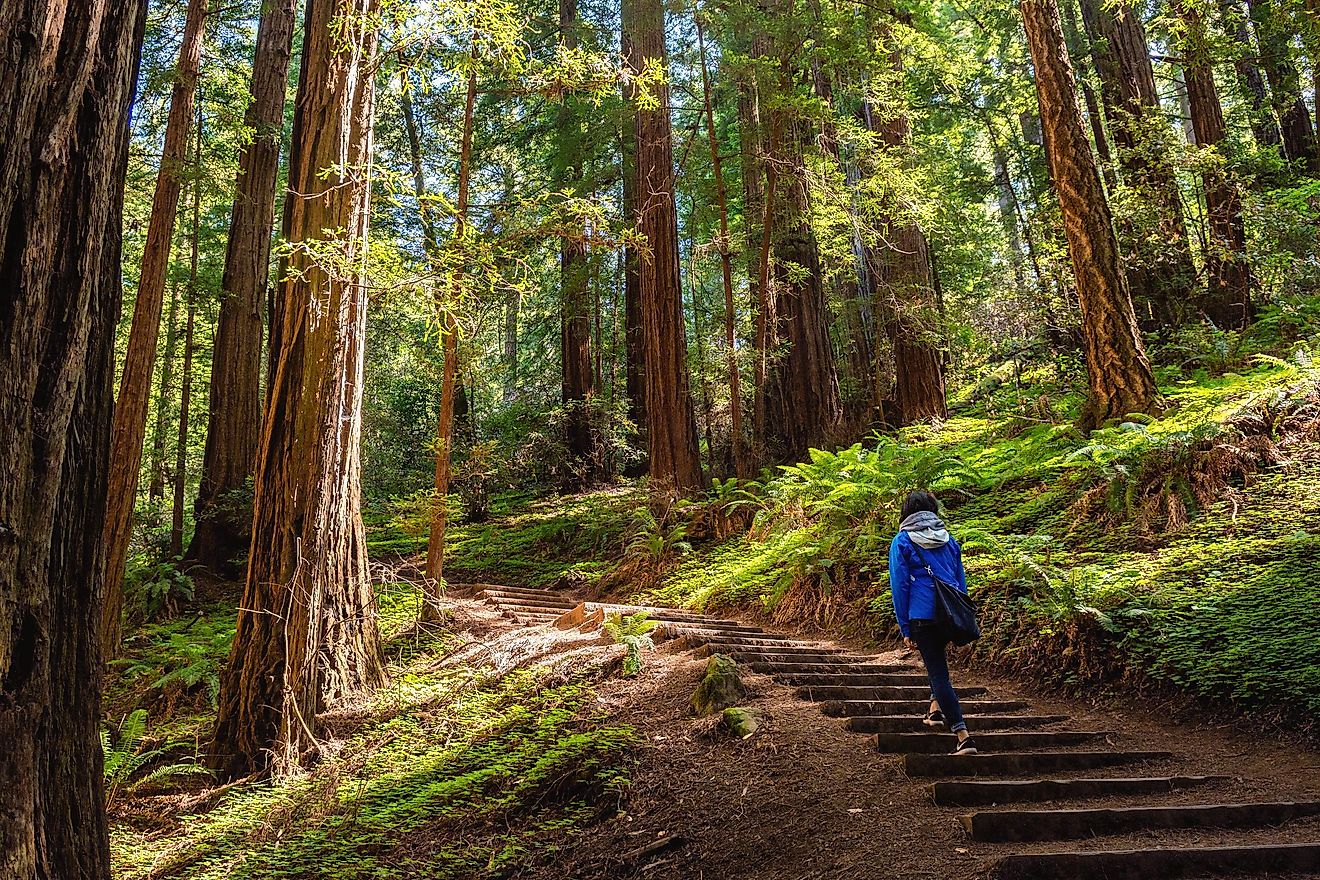Hiking in California offers unparalleled diversity, from the towering redwoods of the north to the sun-baked deserts of the south. This guide explores California’s best hiking trails, categorized by difficulty, highlighting unique geological features, diverse plant and animal life, and the best times to visit various regions. We’ll also cover essential planning aspects, safety precautions, and responsible hiking etiquette to ensure your Californian adventure is both rewarding and safe.
We’ll delve into the distinct characteristics of several iconic hiking regions, comparing coastal and mountainous environments. A sample itinerary will assist in planning your trip, addressing potential challenges and how to mitigate them. Finally, we’ll provide valuable resources and community information to enhance your hiking experience in the Golden State.
California Hiking Regions & Their Characteristics
California boasts incredible diversity in its landscapes, offering a vast array of hiking experiences. From towering redwoods to sun-baked deserts, the state provides trails for every skill level and preference. This section will explore five distinct regions, highlighting their unique characteristics and ideal hiking seasons.
California Hiking Regions: A Detailed Overview
California’s varied geography results in dramatically different hiking environments. Below, we explore five distinct regions, showcasing their unique flora, fauna, and ideal hiking times.
- Yosemite National Park: Characterized by granite cliffs, giant sequoia trees, and cascading waterfalls. Hiking here ranges from gentle valley walks to challenging climbs. Expect stunning views and a high concentration of wildlife, including black bears, deer, and various bird species. The park’s iconic features, like Half Dome and El Capitan, attract hikers from around the world.
- Sierra Nevada Mountains: This vast mountain range offers a wide spectrum of hiking experiences, from alpine meadows to rugged peaks. Higher elevations feature subalpine forests and dramatic granite formations. Wildlife is abundant, with species such as marmots, pikas, and mountain lions. The John Muir Trail, a legendary long-distance hike, traverses a significant portion of this range.
- Redwood National and State Parks: Home to the world’s tallest trees, these parks provide a unique and awe-inspiring hiking experience. Trails wind through ancient redwood forests, offering shade and a sense of tranquility. Wildlife includes Roosevelt elk, black bears, and a variety of birds. The damp, cool environment contributes to a lush understory of ferns and other plants.
- Channel Islands National Park: This archipelago off the Southern California coast offers a unique blend of coastal hiking and island exploration. The trails here showcase dramatic cliffs, diverse plant life adapted to the maritime climate, and abundant marine life visible from the shore. Island foxes, endemic to the Channel Islands, are a highlight of the wildlife here. Hiking involves varied terrain, from relatively flat coastal paths to more challenging inland trails.
When investigating detailed guidance, check out hiking trail dallas now.
- Anza-Borrego Desert State Park: This vast desert landscape offers a stark contrast to the lush forests and mountains of other regions. Hiking here involves navigating sandy washes and rocky canyons under the intense desert sun. The park transforms dramatically after winter rains, showcasing a vibrant display of wildflowers. Wildlife includes desert tortoises, coyotes, and various reptiles and birds adapted to arid conditions.
Coastal versus Mountainous Flora and Fauna
Coastal and mountainous regions of California exhibit significant differences in their ecosystems. Coastal areas, particularly near the Redwood National and State Parks and the Channel Islands, are characterized by a temperate, maritime climate. This results in lush vegetation, including redwoods, ferns, and various shrubs adapted to moisture and moderate temperatures. Coastal fauna includes seabirds, marine mammals, and smaller mammals like deer and raccoons.
In contrast, mountainous regions like Yosemite and the Sierra Nevada experience more extreme temperature variations and higher altitudes. This leads to a different flora, including pines, firs, and other conifers adapted to colder temperatures and shorter growing seasons. Mountainous fauna includes species like black bears, mountain lions, and high-altitude birds.
Best Hiking Times for Each Region
| Region | Best Time to Hike | Reasoning |
|---|---|---|
| Yosemite National Park | Spring (May-June) & Fall (September-October) | Moderate temperatures, fewer crowds than summer, waterfalls still flowing in spring. |
| Sierra Nevada Mountains | Summer (July-August) & Early Fall (September) | Higher elevations snow-free, but be prepared for variable weather. |
| Redwood National and State Parks | Spring (April-May) & Fall (September-October) | Mild temperatures, less rain than winter, lush greenery. |
| Channel Islands National Park | Spring (April-June) & Fall (September-October) | Pleasant temperatures, less fog than summer. |
| Anza-Borrego Desert State Park | Winter (December-March) & Spring (March-April) | Cooler temperatures, wildflowers blooming in spring. |
Hiking Safety and Etiquette in California: Hiking In California

Hiking in California’s diverse landscapes offers incredible rewards, but safety and responsible behavior are paramount. This section Artikels essential safety measures, navigation techniques, wildlife encounter strategies, and the importance of Leave No Trace principles to ensure a positive and safe experience for both you and the environment.
Essential Safety Measures for Hiking in California
Planning is crucial for a safe hike. Before embarking on any trail, check the weather forecast, trail conditions (potential hazards like recent wildfires or trail closures), and inform someone of your itinerary, including your planned return time. Carry a well-stocked first-aid kit containing essentials like bandages, antiseptic wipes, pain relievers, blister treatment, and any personal medications. Always bring plenty of water, especially during warmer months, and high-energy snacks.
Wear appropriate footwear and clothing suitable for the terrain and weather conditions. A map, compass, and GPS device, or at least a knowledge of how to use a map and compass, are vital navigation tools, particularly in areas with limited or unreliable cell service.
Navigation Techniques for California Trails
California’s trails range from well-marked paths to more challenging, less-defined routes. Before heading out, study a detailed map of the trail, noting key landmarks and potential points of confusion. Familiarize yourself with basic compass and map reading skills, and practice using them before your hike. A GPS device can provide an extra layer of security, but it’s important to understand its limitations, particularly battery life and signal availability.
Always leave a copy of your hiking plan with a trusted contact person, indicating your route and expected return time. Pay close attention to trail markers and blazes throughout your hike to ensure you stay on course. If you become disoriented, retrace your steps or find a safe location to wait for assistance.
Strategies for Dealing with Wildlife Encounters
California is home to a variety of wildlife, some of which can be potentially dangerous. Before heading out, research the animals commonly found in the area you’ll be hiking. Maintain a safe distance from all wildlife, never approach or feed them. Carry bear spray in bear country and know how to use it properly. Make noise while hiking, especially in areas with dense vegetation, to avoid surprising animals.
If you encounter a wild animal, slowly back away and avoid making sudden movements. Never approach or corner an animal. If attacked, fight back using whatever means necessary.
Leave No Trace Principles in California Hiking
California’s natural beauty is a shared resource. Practicing Leave No Trace principles is essential to preserving its pristine condition for future generations. This involves planning ahead and preparing properly, staying on designated trails, disposing of waste properly (pack out everything you pack in), leaving what you find, minimizing campfire impacts (or avoiding them altogether), respecting wildlife, and being considerate of other visitors.
Avoid disturbing vegetation or damaging natural features. Proper disposal of human waste is crucial, especially in areas without designated facilities. This involves burying it at least six inches deep and away from water sources.
Hiking Emergency Procedures in Remote Areas
A flowchart illustrating steps to take in a remote area hiking emergency:[A visual flowchart would be inserted here. The flowchart would show a decision tree starting with “Emergency?” Yes would branch to “Assess Situation,” then “First Aid,” then “Call for Help (if possible),” then “Shelter/Signal for Help,” then “Stay Put/Wait for Rescue.” No would branch to “Continue Hike.” Each step would have a brief description.] For example, the “Assess Situation” box might contain the instruction: “Determine the nature and severity of the emergency, injuries sustained, and location.” The “Call for Help (if possible)” box would indicate checking for cell service and contacting emergency services.
The “Shelter/Signal for Help” box would detail building a makeshift shelter and using a whistle or mirror to signal for help.
Exploring California’s vast and varied landscapes on foot is an unforgettable experience. By understanding the diverse regions, planning carefully, and prioritizing safety, you can embark on incredible hikes that showcase the state’s natural beauty. Remember to respect the environment, follow Leave No Trace principles, and connect with the vibrant hiking community. So, pack your boots, grab your map, and prepare for an adventure in California’s stunning wilderness!
FAQ Resource
What’s the best time of year to hike in California?
It depends on the region and your preference. Spring and fall offer pleasant temperatures in most areas, while summer can be very hot in the deserts and winter brings snow to higher elevations.
Do I need a permit for all California hikes?
No, but many popular trails and parks require permits, especially for overnight trips. Check with the relevant park authorities beforehand.
What should I do if I encounter a wild animal?
Maintain a safe distance, never approach or feed animals. If threatened, make yourself appear large and make noise to scare it away. Report any aggressive encounters to park rangers.
How do I prepare for potential emergencies while hiking?
Inform someone of your hiking plans, carry a first-aid kit, navigation tools (map, compass), plenty of water, and a fully charged phone. Consider a personal locator beacon (PLB) for remote areas.

